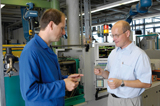Apr 12 2010
Engineers are developing a method to ensure zero-defect manufacturing for metal powder injection molding by adopting neutral networks that utilize complex algorithms for monitoring critical process steps.
 Fraunhofer Savvy Injection Molding
Fraunhofer Savvy Injection Molding
This process will help in saving time and reducing waste for the manufacturers.
The hinges of artificial heart valves, spectacle frames, or surgical instruments use very small metal components. Manufacturers of such components having complex geometries have depended on metal injection molding process for some years now. However, at times things could go wrong during the process, and it is not often possible to identify defects before the sintering process, which is the ultimate step of the process chain, and at that stage it is too late for correcting the mistake.
The Fraunhofer Institute for Manufacturing and Advanced Materials IFAM engineers are focusing on achieving zero-defect manufacturing currently. Their concept is that, at any stage in the molding process, the system must be able keep track of every parameter like temperature, pressure, and weight so that it is possible to provide a verdict related to the component quality. This method will help detection defects like cavities, cracks or warps, as well as dimensional accuracies, according to IFAM’s project manager Dr. Thomas Hartwig. Manufacturers will be able to respond by altering the relevant settings immediately. The system can also be programmed to change the parameters automatically in the long run. The required technical support is offered by a neural network created for metal injection molding (MIM) through collaboration between the private company algorithmica technologies and the IFAM engineers.
Hartwig informed that the self-learning oriented complex algorithms on which the neural network is based offers an advantage to the network over current solutions. The system will be able to interpret every data that is measured, identifying correlations between them that would not be possible to detect without the neural network. The process control system can provide all relevant information to the manufacturer, such as the final component weight when the temperature or pressure is altered during a particular step in the process.
Hartwig informed that the IFAM aims to use the network to decrease rejection rates by a minimum of 50%. He revealed that to meet quality requirements many components had to be rejected by the manufacturers during the initial few days of the manufacturing process so far. Neural networks can also do away with quality checks and used in other production arenas in the industry such as die-casting.